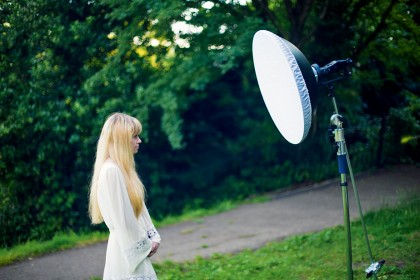Teach yourself flash: Color temperature gels

Everyone shoots during the golden hour, but stay out a little longer and you'll see everything turn a deep blue. This is known as the 'blue moment'. If you turn your camera's white balance to Tungsten the effect becomes even more pronounced, but unfortunately it turns your model blue, too. Lift their spirits (and their skin tone) with a color temperature orange (CTO) gel over the flash. This will make their skin tone look natural while using Tungsten white balance. Let's look at how you get the look...
Step by step: The twilight zone
1. Shallow and late

Around 20 minutes after sunset, the sky will turn deep blue. In aperture-priority mode, use a wide aperture - f/2.8 or faster if possible. Take a shot of your model and make a note of your shutter speed. Switch to manual mode and then dial in the same settings. Reduce the shutter speed by one stop to underexpose the image.
2. Colour Temperature

Put the color temperature orange (CTO) gel on the flashgun and fix it to a light stand. Fix on a diffuser of some sort – we opted for a beauty dish. Trigger the flash with wireless flash triggers if you have them, which sit on both your camera's hotshoe and under the flashgun.
3. Give it some height

Position the flash about a foot above the model's head. Use the broad lighting technique: place the flash camera right or camera left (at whichever side of the model's face you can see most of through the viewfinder). If they're straight-on, it doesn't matter which side you pick.
4. Bright eyes

With the flashgun in manual mode, set it to around 1/16th power to expose the model's face. By under-exposing the background and correctly exposing the model with a flash stronger than the ambient light, the model becomes the brightest part of the scene.
5. Balance those whites

Put the CTO gel over the flash head and set your camera's white balance to Tungsten. This change in white balance will make the backdrop even bluer, while the warm-colored CTO gel will ensure the model has natural skin tone, relative to the white balance.
6. Check for clipping

Take another shot. Check the exposure of the face and look at the histogram to ensure nothing is clipped (bunched up at one end or the other of the histogram). If your model is too bright, as in our first shot, decrease the flash power. Increase it if they're too dark.
Sign up for breaking news, reviews, opinion, top tech deals, and more.
This feature was originally published in N-Photo Magazine, to subscribe, click here